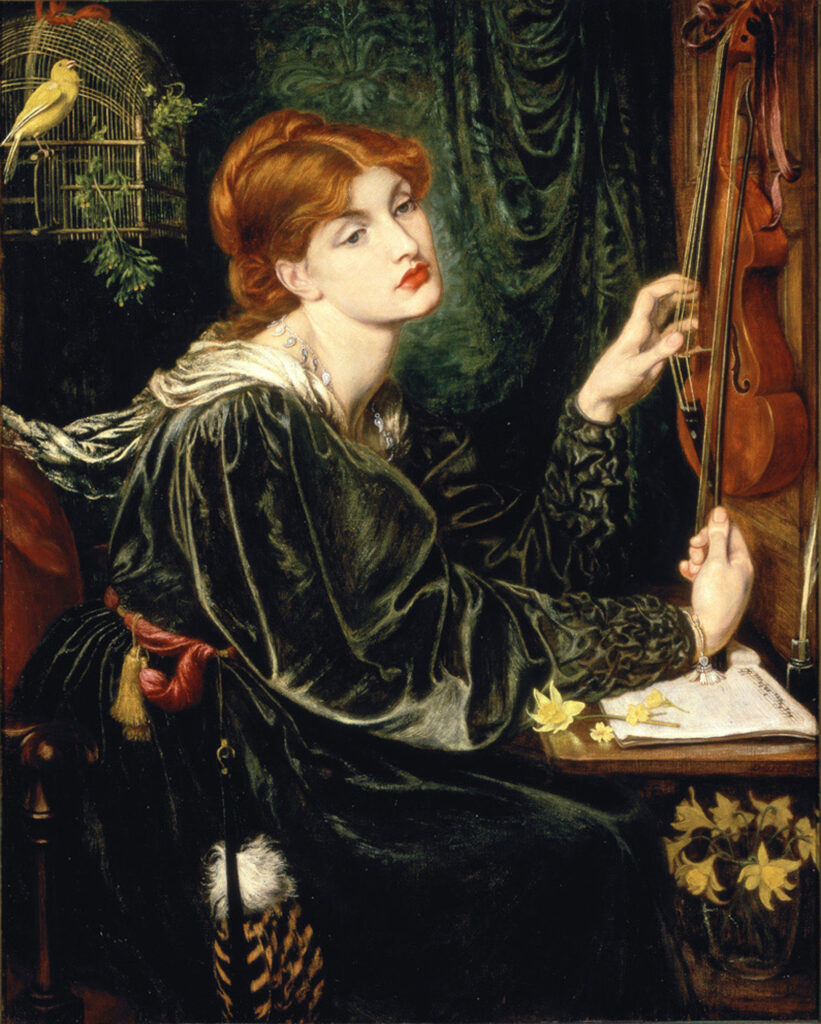 I admit it – I have a penchant for a good painting of an attractive woman. I also like expressive hands. Veronica Veronese has both, executed with uncommon grace and vision, so it’s no wonder I like it as much as I do.
I admit it – I have a penchant for a good painting of an attractive woman. I also like expressive hands. Veronica Veronese has both, executed with uncommon grace and vision, so it’s no wonder I like it as much as I do.
I became a fan of Pre-Raphaelite Brotherhood1 co-founder Dante Gabriel Rossetti when I was a pre-teen, upon seeing Ecce Ancilla Domini: The Annunciation, an early work, in Charles Wentinck’s The Art Treasures of Europe.2 A few years later, almost certainly via the Sacramento Public Library system, I was introduced to Rossetti’s later paintings, including Veronica Veronese. I was definitely already familiar with the piece in 1982, when Bryan Ferry chose it as the sleeve image for the Roxy Music UK single “More Than This.”3 Eventually, when I started painting and formulating ideas for what I wanted my work to be, Rossetti was one of the artists who provided a foundation for that endeavor. The romantic, hallucinatory quality of his work was something I wanted to imbue in my own paintings.
I am fortunate enough to have seen Veronica Veronese during the summer of 2018 in the exhibition Truth & Beauty: The Pre-Raphaelites and the Old Masters, at the de Young Museum in San Francisco. It was my first experience seeing Rossetti’s actual work, 4 and I was quite enamored with the show, which included, among other artists, Edward Burne-Jones, John Everett Millais, Sandro Botticelli, and Jan van Eyck. Even in such lauded company, I found myself looking at Rossetti’s work for the majority of my visit to the museum, and much of that time was spent in front of this particular painting.
The strong verticals and horizontals in the piece provide the basis of the deceptively simple-looking composition. I particularly like how her right wrist is bent forward in such a manner that the forearm and hand form a ninety-degree angle – it appears to be an awkward way to casually hold a bow, but is visually striking and compositionally effective. The implied grid is offset by the skewed fashion in which the figure is holding her head; parallel to this is the diagonal which goes from the bird in the upper left, down the figure’s upper arm, to the flowers in the bottom right. Running perpendicular to these lines, balancing the whole, are the figure’s left hand and her long, columnar neck.
The figure, modeled by Alexa Wilding, who sat regularly and exclusively for Rossetti, delicately touches the strings of a violin with her left hand and holds the bow in her right. Her skin has a glowing, almost otherworldly quality, and her red hair stands out against the green of her dress and of the brocade drapery in the background. The painting is filled with details which add to the lushness of the scene: the ribbon on the scroll of the violin, the sprigs in the birdcage, the silver necklace and bracelet. Her velvety dress is particularly luxurious, and the tassel and feather fan hanging from the waist contribute more texture. The Lady Veronica has left off after writing one staff of music on the paper in front of her – with her heavy-lidded, faraway eyes and somewhat languid expression, she seems transported, possibly by the bird’s song. One of the Pre-Raphaelite’s early tenets was art should be reliant on nature, which here is set free – although there is a cage, the bird is outside of it, perched on the open door. Rossetti also often utilized floral adjuncts in his paintings – in this piece, the daffodils could have some meaning, as he employed both traditional and personal symbolism in his work,5 or they could be included simply for their color, which echoes the yellow of the canary.
Standing before Veronica Veronese was an enthralling experience, one I had looked forward to for most of my life. I may have swooned.
1 A group of young, idealistic nineteenth century British artists, the Pre-Raphaelites were the radicals of the Victorian art world. On the whole, contemporaneous critics found their work, which didn’t conform to the Royal Academy of Art’s teachings, assaultive and vulgar. Although the group was only together from 1848 to 1854, and the principal painters William Holman Hunt, John Everett Millais, and Dante Gabriel Rossetti all went on to have long careers, their respective later styles continued to be thought of as “Pre-Raphaelite.”
2 Simon & Schuster (1974).
3 EG/Polydor Records. In the US, the painting appeared on the sleeve to the “Take a Chance with Me” single, EG/Warner Brothers Records (1982). In their respective countries, each was the first single from the album Avalon, which I love.
4 There were eleven Rossettis total in the show, including another favorite, La Pia de’ Tolomei (1868-1881), and a watercolor version of Proserpine (1878), both modeled by Jane Morris.
5 Illustrator Kate Greenaway’s Language of Flowers lists “regard” as the meaning for daffodils. The book was originally published in 1884; my copy is the Avenel Books reprint (n.d.). In her illustration, Greenaway was heavily influenced by the Pre-Raphaelite Brotherhood.